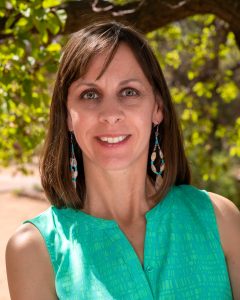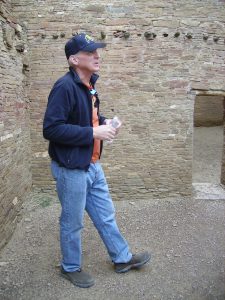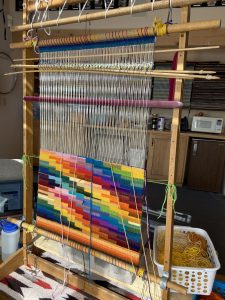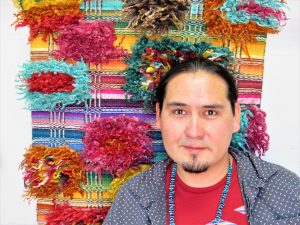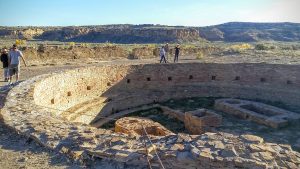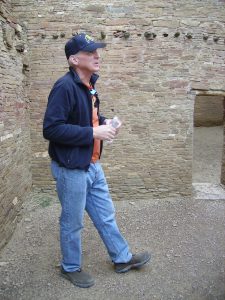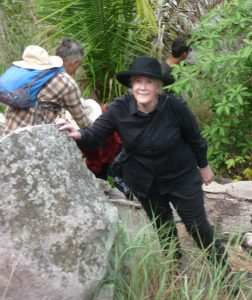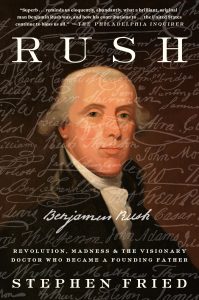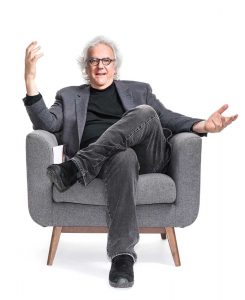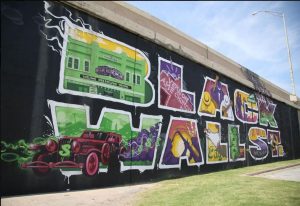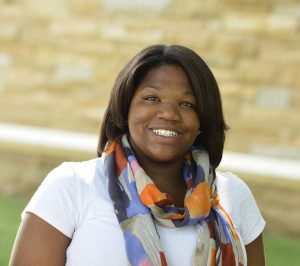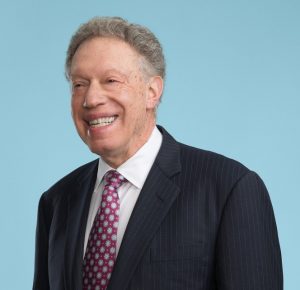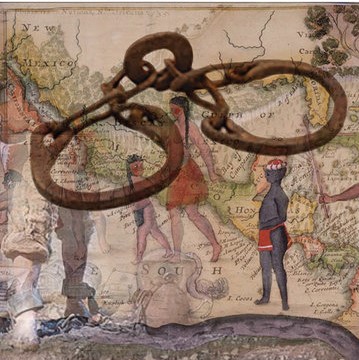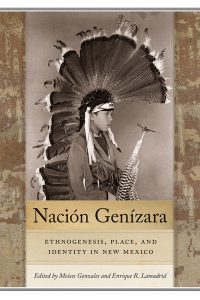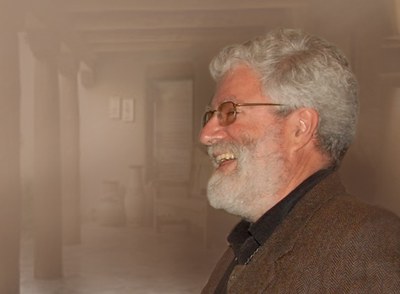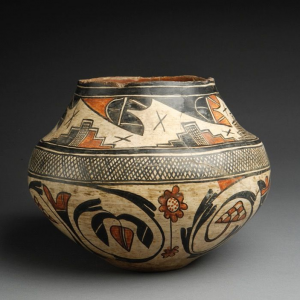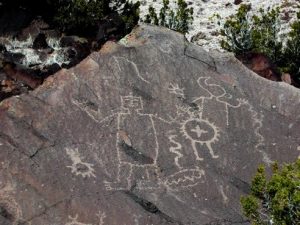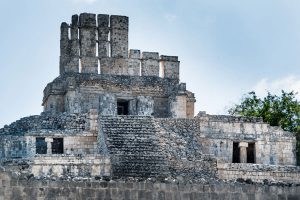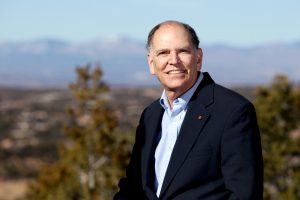The School for Advanced Research offers innovative and thought-provoking classes on a range of topics as a benefit for SAR members. Courses often have opportunities to engage with rarely seen works in the IARC collection or take advantage of the unique resources the campus provides.
If you are not already an SAR member and would like to join to participate in these classes, please click here.
Fall 2022
Caring for Your Personal Collections at Home: An Introduction to Collections Care
Instructor: Laura Elliff Cruz, Collections Manager, Indian Arts Research Center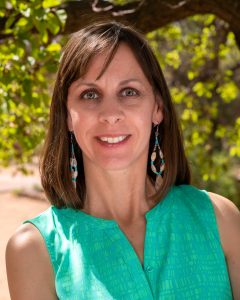
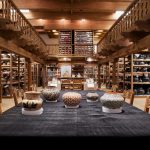
Indian Arts Research Center Vault 1, 2019, photo by Byron Flesher
Class 1: How to Care for your Personal Collections at Home: Establishing a Baseline of Care
Tuesday, December 6, 2022, 10:00 a.m.–11:30 a.m. ONLINE
This class will go over broad concepts of preventive conservation and other agents of deterioration to be cognizant of such as light, pests, environment, water, handling, packing, and much more. Photos and examples will be shared followed by overall tips and a discussion on how collections care is always evolving in the field.
Class 2: A Lightning Round Review of Object Care
Thursday, December 8, 2022, 10:00 a.m.–11:30 a.m. ONLINE
A lightning round of different types of objects that may be in your personal home will be discussed including baskets, ceramics/glass, carved figures/mixed media, metal, paintings and photographs, and textiles. Numerous examples and key resources will be highlighted, and participants are encouraged to also bring specific situational questions for a discussion at the end.
Class 3: Collections Care Visit to Indian Arts Research Center (IARC) Vaults
Tuesday, December 13, 2022, 10:00 a.m.–12:00 p.m., IN PERSON at the School for Advanced Research, 660 Garcia St., Santa Fe
Group size limited to 10 people
This in-depth discussion for a behind the scenes collection care tour in the IARC vaults will wrap up the class. Further conversation of materials and proper housing with options to protect collections in your home will be highlighted.
Class recording: $50
PAST CLASSES
Fall 2021
Weaving the World: Exercises in Writing Evocative Ethnography and Non-Fiction
Course Description:
This course introduces participants to the fundamental features and essential practices of writing ethnography and creative non-fiction. The primary objective of the course is to show participants how to sensuously describe ethnographic spaces, sounds and characters.
Participants will engage in writing exercises that enable them to “Weave the World,” a seamless linkage of sensuous description and social analysis. Participants will also be asked to read examples from the work of writers (including ethnographers) who have, in various ways, successfully used « weaving the world » techniques to evoke places and spaces, develop dialogue and craft character. By the end of the course, participants will have practiced writing strategies that they can use to ensure that their future readers come to know a people who live in a particular place.
During the course participants will be asked to write culture evocatively. The instructor will outline ethnographic writing practices—the “tricks of the trade.” He will then ask the students to begin to “Weave the World” by writing (1) descriptions of space/place, and (2) character portraits.
Course Leader: Paul A. Stoller (SAR’s 1992 National Endowment for the Humanities Resident Scholar, and contributor to several SAR Press publications)
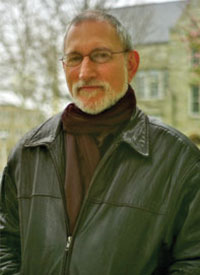
Spring 2021
Spider Woman’s Knowledge and the Survival of Diné Textile Arts
Course Description:
This course explores the work of artist Venancio Aragon through the lens of Diné weaving philosophy and Critical Indigenous Studies. Aragon will interweave history, anthropology, and art to highlight the importance of preserving Native art forms and their power to create change. The course will be taught in three sessions that will each provide a space to learn and discuss topics of importance relating to the overall theme of Diné weaving as narrative.
The first session will focus on the origins of Diné weaving and provide a comparative analysis of Diné oral histories and Anthropological constructions. The second session will explore the influences of designs and materials on Diné weaving in the post 1860’s Reservation era. The third session will examine the Neo-contemporary era of Diné weaving and a discussion of deconstructing how Diné textiles are catalogued by non-Native scholars.
Course Leader: Venancio Aragon
Venancio Aragon is a citizen of the Navajo Nation in New Mexico. Aragon first began learning his art from his mother at the age of ten. He earned degrees in cultural anthropology and Native American and Indigenous studies. Aragon has found methods of fusing his education and culture into his art by researching ancient textiles and techniques, spinning and dyeing fiber and weaving tapestries. Aragon views Navajo weaving as a way to preserve his cultural identity by promoting the continuation and practice of his ancestor’s legacy. Aragon was the 2020 Rollin and Mary Ella King Native artist fellow at SAR.
Venancio Aragon. Photo courtesy of the artist.
Purchase the recorded sessions here
The Archaeology of Chaco Canyon
Course Description:
Archaeological interpretations of Chaco seem to veer back and forth between “mysterious” and “no big deal.” It was neither. Chaco is not difficult to understand in the context of 11th century Native North America: Not mysterious. And Chaco played a pivotal role in the history of the US Southwest and northwest Mexico: A big deal. This course surveys the development of archaeological views of Chaco through the 20th and 21st centuries and how got to mysterious/no big deal; and then looks at what Chaco was (most likely), in the context of Native America in the 10th-12th centuries; and then follows the region’s history, in which Chaco was a climactic event, from the 6th century through the 16th century; and finally suggests what Chaco, properly understood, might offer to History and Science, and its apparently problematic place in Native Heritage.
Course Leader: Stephen H. Lekson
Stephen H. Lekson is the former Curator of Archaeology at the Museum of Natural History, University of Colorado, Boulder. He received his PhD from the University of New Mexico in 1988, and held research, curatorial, or administrative positions with University of Tennessee, Eastern New Mexico University, National Park Service, Arizona State Museum, Museum of New Mexico, and Crow Canyon Archaeological Center. Lekson directed more than 20 archaeological projects throughout the Southwest; about half of his fifty-year career focused on Chaco. Lekson’s publications include a dozen books, chapters in many edited volumes, and articles in journals and magazines. His most recent books include A History of the Ancient Southwest (2009), Chaco Meridian (2015), and A Study of Southwestern Archaeology (2018). He has curated a dozen exhibits, most recently “A History of the Ancient Southwest” (2014) at the CU Museum of Natural History. He retired in 2018.
Purchase the recorded sessions here
Amazonian Art and Ecology: The Great Anaconda and the Amazon Women
Course Description:
This course explores the Amazonian cult of the Woman Shaman and her spirit animal, the anaconda. The art style associated with the cult starts as long ago as 2000 years BP in prehistory and continues to this day among some Amazonian groups.
The great aquatic boa of Amazonia, the anaconda Eunectes spp. (“good swimmer” in Greek), is a fascinating animal with a long history of involvement in indigenous cosmology and culture in the tropical lowlands of South America. Its image and the related spiritual and social concepts are present in various forms in prehistory and among living tribes. Large snakes appear first in astronomical depictions in Paleoindian rock art, and anacondas and their skin patterns become very common in the art of the Polychrome horizon from 2000 years ago to today. In ethnographic cultures, its significance in animistic religion and social organization is made clear in people’s testimonies. For them, a supernatural Great Anaconda is the spirit twin of Woman Shaman, leader of the renowned “Amazon women”. She was the creator of the Amazon and one of the preeminent ancestral deities along with her husband, the Sun. She is said by Amazonians to have invented religion and the arts. In choosing the anaconda for this pre-eminent role in their cosmology and culture, Amazonians were influenced both by their acute observations of anaconda ecology and behavior and by their deep understanding of human relations with the environment and each other.
Across the three sessions Anna Roosevelt will present the archaeological evidence of the cult and its relationship to settlement patterns; the ethnographic evidence of its importance in myth, ritual, and art; and the varied influence of the cult in the social organization of the societies of its adherents.
Course Leader: Anna C. Roosevelt
A.C. Roosevelt is a four-field anthropologist interested in social and biological evolution, human-environment interaction, and human rights. She has been a professor of anthropology at the University of Illinois, Chicago, since 1994. Prior positions include curatorships at the Museum of the American Indian, the Field Museum, the American Museum of Natural History and visiting/adjunct positions at NYU, Harvard, and University of Florida. She is also an adjunct professor in the doctoral program “History and Atlantic Connections: Cultures and Powers”, at the Federal University of Maranhao, Sao Luis, Brazil.
Her research on the history and prehistory of the tropical forests and the peopling of the Americas has been funded by the National Science Foundation, Fulbright, National Endowments for the Humanities and the Arts, the University of Illinois at Chicago, and other agencies. Roosevelt is a fellow of the American Academy of Arts and Sciences, the American Association for the Advancement of Science, American Anthropological Association, and the MacArthur Foundation and has been awarded medals from Brazil, the Society of Women Geographers, and the Explorers Club.
Fall 2020
Reliving the Revolution with Dr. Rush
Course Description:
This course takes you on a three-part journey from the earliest days of the American Revolution, through the war, the Constitution, and the first decades of governing the new nation all through the unique perspective of Dr. Benjamin Rush, signer of the Declaration, best friend of John Adams and Thomas Jefferson, physician to the revolutionaries and their families, and recently rediscovered “lost” founding father.
Stephen Fried is an award-winning journalist and bestselling author who teaches at the Columbia University Graduate School of Journalism and the University of Pennsylvania. Mr. Fried is the author of six nonfiction books including the biographies Appetite For America: Fred Harvey and the Business of Civilizing the Wild West—One Meal at a Time and Thing Of Beauty: The Tragedy of Supermodel Gia; investigative books Bitter Pillsand The New Rabbi and the essay collection Husbandry. He is co-author with Patrick Kennedy of A Common Struggle: A Personal Journey Through the Past and Future of Mental Illness and Addiction. His latest book, Rush: Revolution, Madness & the Visionary Doctor Who Became a Founding Father, was a finalist for the George Washington Book Prize, and one of the American Library Association’s twelve notable nonfiction books of the year. A two-time winner of the National Magazine Award, he has been a staff writer for Vanity Fair, GQ, Glamour and Philadelphia magazine. Mr. Fried and his wife, author Diane Ayres, live in Philadelphia, a few blocks from where Dr. Rush lived and the nation was born. Mr. Fried received his B.A. from the University of Pennsylvania.
Stephen Fried. Photo courtesy of Stephen Fried.Purchase the recorded sessions here
Unearthing Violence: Archaeology in the Aftermath of the Tulsa Race Massacre
Course Description:
Next year will mark 100 years since the 1921 attack on Greenwood destroyed what was commonly known as Black Wall Street, one of the most prosperous Black communities in the early twentieth century. In the wake of renewed public interest in this story from the HBO series Watchmen and a long awaited search for mass graves, the nation is fixated on unearthing evidence of trauma and violence done to this historic community. However, a new collaborative archaeology project titled “Mapping Historical Trauma in Tulsa from 1921 to 2021” remains focused on finding signs of life and recovery in the aftermath of the massacre, as the Greenwood community rebuilt their homes, businesses and churches. They continue to fight against erasure and gentrification in the present day.
Today, most of the survivors of the Tulsa Race Massacre are gone but generations of descendant families, social justice activists, educators, civil servants and archaeologists have banded together to unearth another side of the story of Greenwood after the massacre. Tulsa offers a unique case study in community archaeology and restorative justice since descendants and modern day residents within the Historic Greenwood District are seeking justice for themselves using archaeology in all its forms to reclaim the story of Black Wall Street and find their own lost heritage and people.
Course Leader: Alicia Odewale
Dr. Alicia Odewale is an Assistant Professor of Anthropology at the University of Tulsa. She specializes in African Diaspora archaeology in the Caribbean and Southeastern United States. Since 2014 she has been researching archaeological sites related to Afro-Caribbean heritage on St. Croix, U.S. Virgin Islands but continues to research sites of African heritage in Oklahoma, Virginia, Arkansas, and Mississippi. While she researches both urban and rural sites of enslavement in St. Croix, her latest project is based in Tulsa and seeks to reanalyze historical evidence from the 1921 Tulsa Race Massacre. The work includes launching new archaeological investigations in the historic Greenwood district, and using radical mapping techniques to visualize the impact of the massacre through time on the landscape of Greenwood, utilizing a slow community-based approach. She has received awards and support from the American Anthropological Association, the National Science Foundation, the Society of Historical Archaeology, the Tulsa Race Massacre Centennial Commission, and the Digital Archaeological Archive of Comparative Slavery (DAACS). In addition to her role as faculty, she also serves as the director of the Historical Archaeology and Heritage Studies Laboratory at TU and serves as the co-creator of the Estate Little Princess Archaeological Field School in St. Croix that trains local students in archaeological methods and other STEM related skills for free.
Purchase the recorded sessions here
Topics in American Legal History: The Rule of Law
Course Description:
This course will examine major themes in the history of American Law from the legacy of the Magna Carta to the most significant recent decisions of the Supreme Court. Topics will include establishing the rule of law in remote colonies, the law of slavery and the legal consequences of the Fugitive Slave Law, the role of contract law in creating a dynamic economy, the dispossession of Native Americans, crime and punishment, the internment of American citizens of Japanese descent, and the right to privacy. The goal of the course is to give an understanding of the history of law in America and its influence on society over time. Readings will consist of edited cases and decisions.
Michael Hindus. Photo courtesy of Michael Hindus.Course Leader: Michael Stephen Hindus
Michael Hindus earned his AB from Columbia, his Ph.D. in history from Berkeley, and his JD from Harvard Law School. He is the author of two books and numerous articles in legal history. He taught legal history at the University of Minnesota and Stanford Law School and currently teaches a seminar in legal history at Columbia. As an attorney in private practice for nearly four decades, he was a partner in the San Francisco office of an international law firm where he specialized in renewable energy.
Spring 2020
Nuevo México Profundo – Indo-Hispano Narratives of Conquest and De-Conquest
Course Description:
Explore the evolution of the history and the changing paradigms around New Mexico’s hegemonic multi-culturalism with the University of New Mexico’s former director of Chicano Hispano Mexicano Studies, Enrique Lamadrid.
From triumphalist accounts of Spanish conquest and re-conquest to contemporary battles surrounding the tri-cultural myth of the region, this course introduces participants to the power of collective memory in shaping the historical narratives within a contested region at the edges of empire, where conquerors are conquered in turn, and where discourses of power have morphed into discourses of survival. As Lamadrid notes, “Indo-Hispano cultural knowledge has much to contribute to a global conversation about the limits of empire in our own times.”
Course Leader:
Enrique Lamadrid
Enrique Lamadrid is Professor Emeritus and Distinguished Professor of Spanish at the University of New Mexico where he has taught folklore, literature, and cultural history in the University’s department of Spanish and Portuguese. Lamadrid is the former director of Chicano Hispano Mexicano Studies at UNM, has served as a field worker and presenter for the Smithsonian Institution’s Festivals of American Folk Life, and has done extensive work for the Museum of New Mexico and National Hispanic Cultural Center. He still organizes local and international field schools in ethnographic documentation and cultural cartography, most recently based in Ecuador, Mora and Rudolfo Anaya’s home town, Puerto de Luna. Among other awards, Lamadrid has received the Chicago folklore prize for his 2003 ethnography Hermanitos Comanchitos: Indo-Hispano Rituals of Captivity and Redemption and the North American Academy of the Spanish Language’s (ANLE) Enrique Anderson Imbert national prize in 2019. He is the editor or author of several publications including Linking the Histories of Slavery, North America and Its Borderlands (SAR Press 2015), Santa Fe Nativa: A Collection of Nuevomexicano Writing (University of New Mexico Press, 2019) and Nación Genízara Ethnogenesis, Place, and Identity in New Mexico (University of New Mexico Press 2019).
Enrique Lamadrid
Cancelled: From Tsankawi to San Ildefonso; Pueblo Pottery at SAR and the Museum of Indian Arts and Culture
Course Description:
Learn about San Ildefonso culture and ceramics with Bruce Bernstein, Director of Innovation & Senior Curator at the Coe Center, and award-winning potter, Erik Fender. Our course will explore this community of makers and their continued inspirations and contemporary challenges. Across two sessions participants will learn about the evolution of the region’s pottery through an in-depth look at pieces in the collections at SAR, and those exhibited as part of the Museum of Indian Arts and Culture’s current exhibit, “Voices in Clay: San Ildefonso Pottery 1600 – 1930.”
Course Leader:
Bruce Bernstein
Bruce Bernstein is the Director of Innovation & Senior Curator at the Coe Center, where he develops public programming, working directly with Indigenous artists and the permanent collection of traditional arts. His previous positions include Assistant Director for Collections and Research at the National Museum of the American Indian, Smithsonian Institution; Chief Curator and Director of Santa Fe’s Museum of Indian Arts and Culture and Laboratory of Anthropology; and Executive Director of the Southwestern Association for Indian Arts. He has dedicated his three decades of work in museums to collaborative work and modeling new partnerships.
Fall 2019
Rock Art of the Rio Grande Basin in Northern New Mexico
Course Description:
Explore the history and evolution of rock art across the Rio Grande Basin with archaeologist, Richard Ford. This four-part course introduces participants to a wide range of rock art including Paleo-Indian, Early/Middle/Late Archaic, historic Pueblo, and the migratory Plains style. Learn how to identify rock art, record the works, and where to find nearby examples. This course is presented in four parts:
October 1: Cupules (their manufacture and meaning) with class demonstration
– Paleo-Indian rock art: what it means and where you find it
– Conventions and protocol for recording rock art
October 8: Archaic Rock Art
– The importance of shamanism and sacred shrines in the Archaic, the meaning of abstract art, and the Rowe Mesa rock art tour
– Early Archaic
– Middle Archaic
– Late Archaic and Transitional rock art
October 15: Ancestral Pueblo imagery: styles, meaning, and history
October 22: Historic Hispanic, Genízaro, and Catholic religious imagery
– Migratory Plains Indian rock art (Ute, Jicarilla Apache, and Comanche glyphs)
– Anglo-American images
– Where to find rock art in the greater Santa Fe area
Course Leader:
Richard I. Ford
Richard Ford, Arthur F. Thurnau Emeritus Professor of Anthropology, University of Michigan, completed his BA in anthropology at Oberlin College and then his PhD in anthropology at the University of Michigan, where he rose to the rank of full professor of anthropology and botany. While at Michigan, he had administrative appointments as curator of ethnology and director of the Ethnobotanical Laboratory in the Museum of Anthropology, director of the Museum of Anthropology, chairman of the Department of Anthropology, and associate dean of research and computing in the Literary College.
Professor Ford’s ethnobotanical research took him to Poland, Tunisia, Kenya, Mexico, Canada, the Bahamas, China, and several Midwestern and Southwestern states. Based on this travel, he published 135 articles and chapters and nine research monographs.
He received numerous awards from professional organizations including the Amal Amique Award in India, Distinguished Ethnobiologist from the Society of Ethnobiology, the Fryxell Award from the Society of American Archaeology, the Franz Boas Award from the American Anthropological Association, and election to the American Academy of Arts and Sciences, as well as numerous local honors.
Now residing in Santa Fe, Ford is an active lecturer and archaeology tour guide. He also serves as an expert witness for several pueblos in their land and water cases.
An Introduction to the Archaeology of Ancient Maya Civilization
Course Description:
How are recent archaeological studies exploring Pre-Columbian Maya civilization shaping our current understanding of the culture and history? Join Dr. Jeremy Sabloff in a 4-part course exploring the evolution of the field of Maya studies. From new discoveries unlocked through Maya hieroglyphic texts to developments in understanding the settlement patterns of urban centers, Maya archaeology has shifted archaeological studies away from their concentration on the ruling elites to a broader, more realistic approach that looks at all classes and populations, as well as continuities in cultural development over 2 millennia.
This course is presented in four parts:
November 5: An overview of the history of research on the Pre-Columbian Maya and the changing foci of scholars over the past century;
November 7: An exploration of the development of ancient Maya civilization in the lowlands of the Yucatan Peninsula, and the environment, both natural and cultural, within which it grew as well as a concentration on the Preclassic Period (from about 1,000 B.C. to A.D. 250) and the rise of complex societies in the Maya area and its first cities;
November 12: A look at the Classic (A.D. 250-800) and Terminal Classic (A.D. 800-1,000) Periods including the growth of Maya cities such as Tikal and Caracol, the great achievements in art and architecture, the decline of cities in the Southern Lowlands and the florescence in the north;
November 14: And, an exploration of the Postclassic Period (A.D. 1,000 to 1519) including the economic and political developments at cities such as Chichen Itza and Mayapan and the consequences of the 16th century Spanish Conquest.
Course Leader:
Jerry Sabloff
Jerry Sabloff received his Ph.D. In anthropology from Harvard University and his B.A. in anthropology from the University of Pennsylvania. He is the Christopher H. Browne Distinguished Professor of Anthropology, Emeritus at the University of Pennsylvania and an External Professor Emeritus and Past President of the Santa Fe Institute. He is an archaeologist with particular interest in the ancient Maya and has written or edited more than 20 books and monographs (including 4 SAR volumes).
Fall 2018
Edgar Lee Hewett and the Early Pioneers of Southwestern Archaeology
Course Description:
In 1907 the Archaeological Institute of America supported the founding of a new
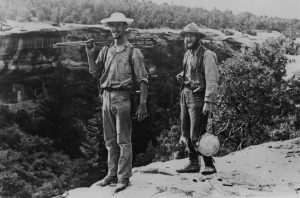
Jesse Nusbaum and Alfred V. Kidder, Mesa Verde, 1908. Photo courtesy of Faith Kidder Fuller.
School of American Archaeology (what would eventually become the School for Advanced Research). Edgar Lee Hewett, an educator and emerging archaeologist at the time, became the school’s first director. He was instrumental in the development of the Archaeological Society of New Mexico and the Museum of New Mexico. He is often credited with shaping the burgeoning field of Southwestern archaeology in the early twentieth century. His long career reflected a larger-than-life persona, which contributes to the public attention he has received over the years. A less-explored subject is the coterie of ambitious young scholars and field workers who surrounded him. This course explores the lives of these influential scholars, their impact on the developing field of archaeology, and their changing views of the Southwest’s indigenous societies prior to contact with Europeans. With a particular focus on Sylvanus Morley, Jesse Nusbaum, and Kenneth Chapman, this course will also consider the work of John Fletcher, Frederick Hodge, A. V. Kidder, Ralph Emerson Twitchell, and John Harrington, among others.
Course Leader:
Jason S. Shapiro, PhD, was a long-time adjunct professor at the College of Santa Fe. An archaeologist, he has participated in a number of digs in New Mexico and Maryland. He is the author of A Space Syntax Analysis of Arroyo Hondo Pueblo, New Mexico: Community Formation in the Northern Rio Grande (SAR Press) and Before Santa Fe: Archaeology of the City Different (Museum of New Mexico Press).
Spring 2018
After the Fall of Chaco Canyon Society—Four Centuries of Consequences
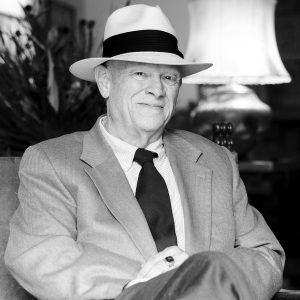
David E. Stuart
Photo by Jason Ordaz.
Course Description:
The 1100s to 1400s were a crucial time in the prehistoric American Southwest. The Chacoan world, a great power in the 1000s AD, unraveled, leaving decimated communities, violence, hunger, and refugees. Most of those refugees fled to the uplands in the 1100s. Then climate changes forced them to again reorganize. This course focuses on climate, well-being, methods of food production and the dynamics of change in communities, whose inhabitants learned that values of community and efficiency were more important than political and economic power. We will see and discuss parallels to current America.
Course Leaders:
David Stuart is an internationally recognized anthropologist whose most cited books are Prehistoric New Mexico, Anasazi America, The Guaymas Chronicles, and the recently released Ancient People of the Pajarito Plateau. He earned his PhD in anthropology from the University of New Mexico (UNM) and served many years at UNM as associate provost for academic affairs. Stuart served as acting president of SAR and has been a lecturer there and in Edinburgh, London, Mexico City, and the Sorbonne in Paris.
Rory Gauthier retired from the National Park Service after more than thirty years working as an archaeologist, curator, and interpreter, along with ten years in law enforcement. During his park service years, he was assigned to Bandelier National Monument, Chaco Culture National Historical Park, Glen Canyon National Recreational Area, Petrified Forest National Park, and El Morro and El Malpais National Monuments. He has also worked on a number of archaeological projects throughout the southwestern US for the University of New Mexico and the Museum of New Mexico. His archaeological interests have focused on the northern Rio Grande region and the subjects of pueblo agricultural traditions and pueblo migrations and adaptations. He is currently working with Aspen Cultural Resource Management Solutions in Santa Fe.
David Stuart and Rory Gauthier are co-authors of the ground-breaking work Prehistoric New Mexico.
Pueblo Worlds: An Overview of Pueblo Society and Culture
Course Description:
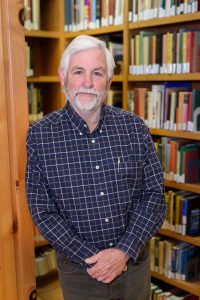
John Ware
© School for Advanced Research
When sixteenth-century Spanish explorers first set foot in what is now the southwestern U.S. they encountered people who lived in multistoried apartment buildings of stone and adobe enclosing communal plazas. The Spanish referred to these people as Pueblos (Spanish for towns), presumably to distinguish them from the residentially-mobile band and tribal groups of the greater Southwest. Despite similarities in architecture and settlement pattern, the people the Spanish called Pueblos speak six mutually unintelligible languages from four different language families, so they are not a monolithic culture but several different peoples who share cultural practices. The Pueblos have also shared more than a century of scrutiny by anthropologists, archaeologists, and historians attempting to sort out their convergent histories. It is likely that no other indigenous cultures in the world have been studied more intensively than the Pueblo people of the Southwest. Pueblo Worlds is a School for Advanced Research mini-course that will explore the many worlds of the Pueblo Indians of New Mexico and Arizona.
Course Leader:
John Ware is an anthropologist and archaeologist whose teaching and research concerns focus on the indigenous cultures of the northern Southwest, where he has worked for almost 50 years. From 2001 until his retirement in 2014, Dr. Ware served as executive director of the Amerind Foundation in southern Arizona. Before that he directed the Laboratory of Anthropology and was founding director of the Museum of Indian Arts and Culture in Santa Fe. He is the author, most recently, of A Pueblo Social History: Kinship, Sodality, and Community in the Northern Southwest (SAR Press, 2014).
Fall 2017
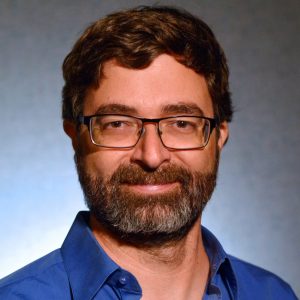
Photo courtesy of Paul Ryer.
Inside The Revolution: An Anthropological Approach to Contemporary Cuba
Course Leader: Paul Ryer, SAR Director of Scholar Programs
This course will investigate the nature of social life in Cuba today, within the historical and ethnographic context of a still-socialist revolutionary state in the Caribbean. After a brief historical overview of Cuban society before 1959, we will consider the formal and informal socialist economy established during the Soviet era; gender relations, racial identities, and migration; arts, material culture, religion, and politics within one of the more distinctive republics in the Americas today.
Combining lectures and discussion of related readings, the class is intended as a brief stand-alone introduction, but also to prepare participants for the subsequent SAR trip to Cuba, November 1-8, 2017. Both the class and the trip will be led by Dr. Paul Ryer, SAR director of scholar programs. Ryer was affiliated with the University of Havana and has conducted long-term research on Cuba and its diasporas.
Week One: Tuesday, Oct. 3
From Colony to Revolution
Week Two: Tuesday, Oct. 10
State Socialism
Week Three: Tuesday, Oct. 17
Daily Life in the Post-Soviet Era
Week Four: Tuesday, Oct. 24
Arts, Material Culture, Religion, and Politics Today
Spring 2017

Photo by Jason Ordaz.
From Casual Farmers to Chaco Canyon: Archaeology and the Dynamics of Prehistoric Four Corners Society
Course Leader: David Stuart
How did a few scattered families of part-time horticulturalists in about 1500 B.C. make modest decisions that would transform their descendants into the full-time farmers of the 900s A.D. who supported and shaped the rise of Chacoan Great House Society in the late 1000s A.D.? The answers involve ecology, climate, reproductive and social behaviors, massive amounts of labor, a penchant for problem-solving, and lots of innovation.
David Stuart is an internationally recognized anthropologist whose most cited books are Prehistoric New Mexico, Anasazi America, The Guaymas Chronicles, and the recently released Ancient People of the Pajarito Plateau. He earned his PhD in anthropology from the University of New Mexico and served many years at UNM as associate provost for academic affairs. Dr. Stuart served as acting president of SAR and has been a lecturer at SAR and in Edinburgh, London, Mexico City, and at the Sorbonne in Paris.
